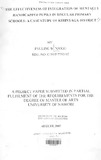| dc.description.abstract | This study examined the effectiveness of the integration of mentally handicapped pupils in regular primary schools within Kirinyaga District. The need for the study arose from the realization that opportunities for children with disabilities have been extremely limited in Kenya just like in other developing countries. Relatively few children with mental handicap have had access to education, due to inadequate special education facilities and other forms of rehabilitation services.
However, since the introduction of free primary education in 2003, many pupils with special needs have been enrolled in regular primary schools in response to the inclusive education approach. It is estimated that a high number of pupils with mental handicap are integrated in regular primary schools, because the existing special education programmes cannot accommodate all the identified children. The study set out to establish the enrolment of mentally handicapped pupils who were integrated in primary schools, to establish preferred school placement options and to find out the challenges which were being encountered as a result of integration.
Kirinyaga District which is in Central Province, Kenya, was purposively selected for the study. The study employed stratified random sampling to select four primary schools from the four divisions in the district. Another four primary schools hosting the oldest special units for mentally handicapped pupils were also purposively- selected, from the four divisions. The respondents were 109 primary school teachers. while the fifteen key informants consisted of primary school head-teachers and assessment officers. Additional data was collected through observation and also from secondary sources.
The Statistical Package for Social Science (SPSS) was used to analyse the data. During the study, approximately half of the respondents confirmed that there were mentally handicapped pupils in their classes while others cited that poor academic performance was a key identification characteristic. Other characteristics were strange behaviors, withdrawal and
aggressiveness, lack of concentration. communication problems and 'queer facial appearances.
The study revealed that majority of the respondents felt that special institutions were the best placement option for mentally handicapped pupils because teachers with special education training were better equipped to teach them. Only a minority of the respondents had attended in service courses in special education and therefore, the majority did not feel competent enough to teach the mentally handicapped children.
Some respondents, who supported integration of mentally handicapped pupils' indicated that some of the academic benefits which they gained were acquisition of basic academic skills, learning from other pupils, while social benefits included socialization and interaction, improvement of communication skills and 'normal' pupils would learn how to live with them.
The challenges which were cited included negative attitudes from teachers and pupils, others cited inadequate special education teachers, poor performance and inadequate facilities. Most of the respondents indicated that the mentally handicapped pupils were more vulnerable and at high risk of being abused, because they could not make informed decisions.
Several key recommendations were made to improve the effectiveness of the integration of mentally handicapped pupils in regular primary ,schools; which include introduction of new innovations in the education system to increase the-competence of primary school teachers, through district in-service courses on special education and early intervention through comprehensive early childhood education programmes.
The Ministry of Education should also formulate clear guidelines on inclusive education for children with special needs. The School Based Teachers Development programme (SbTD), should recruit a Key Resource Teacher (KRT), in every primary school to specialize in special education. Sensitization and creation of awareness in the schools and community should be
enhanced in order to address the negative attitudes towards pupils with mental handicap in
,
regular primary schools within the district. Further research should be carried out on the
integration of pupils with other types of disabilities in the district and on parents' perceptions on the integration of children with mental handicap. | en |

